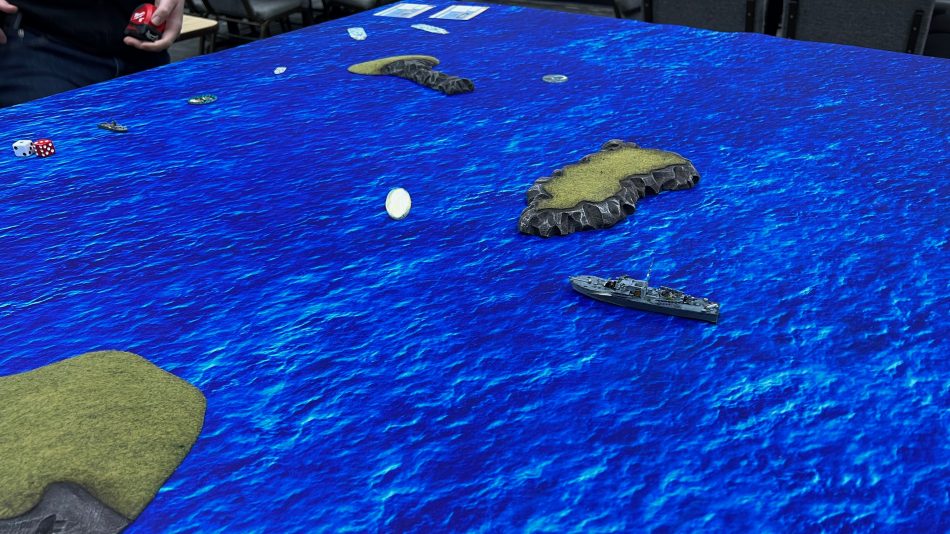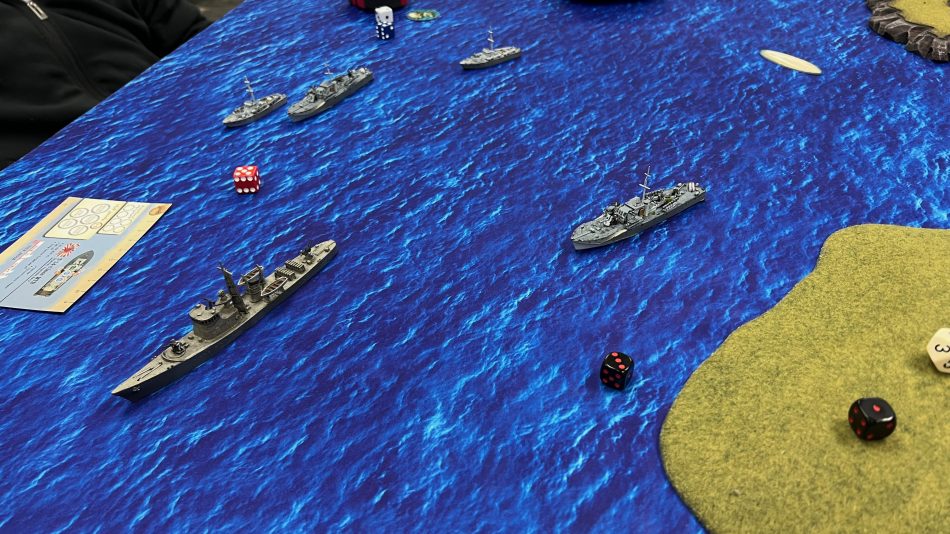Coastal Patrol – WWII Small Ship Skirmish Rules
By Tom Gall
As someone that bought into the Cruel Seas rules and range by Warlord when it came out back in 2018, I was sad to hear that Warlord has paused the Cruel Seas system. We had been hoping for a second edition of the rules and repointed forces to help with balance. With that not happening in the near future, our local group started looking for a different ruleset to test the waters with.
Where does one with a range of 1/300 WWII MTBs look for a simple ruleset to play? Too Fat Lardies, of course. This article is about Coastal Patrol by James Schmidt. This was our local game group’s first experiment away from Cruel Seas while still using the line of boats from Warlord.
Coastal Patrol was published by Two Fat Lardies out of the UK. This is the same company that publishes Chain of Command, Sharp Practice, and a number of other titles. The game is obtained in the Summer Special 2011 issue of Lard Magazine. Located on pages 64-81 the rules are straightforward and to the point. The game is advertised for use with 1/1200 or 1/600 ships but they worked well for my existing 1/300 Warlord ships.
The ship stats are included with the rules in the magazine.
Activation and Actions
The activation system is card-based, where each ship has a card assigned. When revealed from the deck, it is activated for its turn. It will have a variable number of actions determined by crew quality and a die roll. You might get three actions, or in the rare case, none!
If you have an affinity for the Warlord style activation, based on pulling a die out of a bag and choosing which ship you want, that method certainly works too and gives players more freedom to pick which of your ships is going next.
As mentioned each boat will have a budget of actions to spend, these include such things as turning, increasing/decreasing speed, firing weapons in a variety of ways, firing a torpedo, spot, fighting a fire, and so on. Regardless of the number of actions, your boat will move at the speed to which it is currently set. Boat crews can be rated Veteran, Regular, or Green. When the boat is activated, its crew rating is compared with the number roll on 2d6. Veteran crews may take three actions on a roll of up to 8. A 9 is two actions. A 10 is one action. Regular crews get three actions on a roll of up to 7. Green crews get three actions only on a roll up to 6. This adds a nice mechanic of variability from turn to turn what each boat does.

Blinds and Spotting
Coastal Patrol is based on night-time scenarios, so the system uses blinds and spotting rules. Players are encouraged to use a bind marker to make their opponent guess what is in each “blind” or formation. If a blind is successfully spotted, the blind marker is replaced with a marker for each ship. The individual boats must then be successfully spotted to be identified.
Spotting is based on speed, distance, and size of the target, and is done with a 2d6 roll. Potential ship chances of being spotted range from 1-11 down to 1-3 (on 2d6) before modifiers are applied.
Movement is fairly what you see is what you get. An MTB moving at high speed is on the order of 14”. Turn radius as a function of the size of the boat is used which is quite a bit more functional as compared to the turning system used in Cruel Seas.

Firing takes a couple of forms that can be confusing as you get started with the rules.
There are automatic fire and single fire weapons. Automatic weapons are each rated with a firepower faction that is tallied into a single number and indexed into a table to tell you how many D6 to roll.
You consult the range, (in inches), which gives you a value you need to hit, apply modifiers, and for each success score a hit.
Single fire weapons (like a 6pdr) roll one d6 per weapon. The roll to hit is based on the range. If these single fire weapons are successful then the number of hits is determined by the size of the weapon. A 6pdr for instance will generate three hits.
Damage?
One of the major departures from other games is that ships in Coastal Patrol have no concept of hull points. This leads to an Innovative system of dealing damage.
For each hit achieved you resolve the result on a table appropriate for the class of ship. There are six such classifications. For each of these six, you roll 2d6 with one die determined as “first” and the other “second”. This brings you to yet another table that usually yields damage.
There are some cases where the result is no effect. Basically, you’re destroying a boat through critical hits. Some hits make the owner of the boat perform a Flooding, Explosion, or a Fire test. You mark off a box for the appropriate test and then roll a d6. If you score the number of boxes marked off or less that particular “bad” event happens. For example, if a hit makes you take a fire test, you mark off the first fire box, and then roll a D6, if you roll a one, a fire breaks out.
The second box checked, increases the chance of a fire, now on a one or a two, and so on. Three boxes checked, means it happens on a one, two, or three.
This makes for some good game dynamics. No more watching your hull points thinking you’re protected as long as you have ample to wear away.
Without hull points, it also makes it far easier to create ship stats. This is more a matter of recording the armament on the ship along with plugging it into a reasonable classification.

Generally, I like the Coastal Patrol set of rules. The two fire modes, automatic and single fire can be a little confusing for players, and begs the question could it be streamlined just a bit? Modifiers across the system are reasonable. The rules indicate they assume a nighttime setting which is when this class of hardware was more likely to be active on some mission.
Given the cost of the rules at £5.50 (including the rest of the online magazine), it makes for good value if you are searching for something to play the period, with several scales of models, including Warlord’s 1:300 Cruel Seas line of models.
